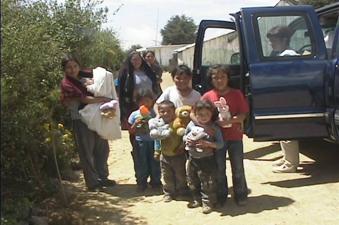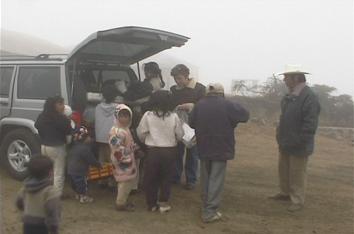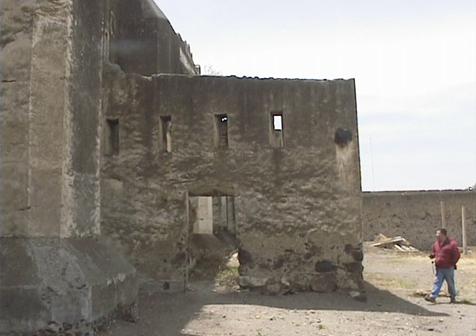By Esperanza Carrasco and Janina Nava
Tonantzintla,
Pue. June 17, 2004.- As part of the activities developed
by the LMT project, you will find a brief description
of the communities that surround Sierra Negra and a short
explanation of how this project has had social, economical
and cultural influence in them.

Figure 1. INEGI [1] Map of the region.
North is upwards. Texmalaquilla is at 5.3 km from the
summit, Atzitzintla is at 9 km and Cd. Serdán is
at about 14 km.
Texmalaquilla
Texmalaquilla,
at 3100 m above sea level, is 5.3 km from the summit,
see Figure1. It is a small community of about 1300 inhabitants
[1]. The main activities are rainfall farming of potatoes,
peas, lima beans, cattle and sheep. In Texmalaquilla there
are three schools: a kindergarten, a rural elementary
and a distant junior high school. The kindergarten has
very little attendance. In elementary school there are
about 360 students at all levels during the school year.
In contrast, this year there are only 45 students at the
junior high school but the school drop-out rate about
40% is expected, as many of students have to work in the
farm fields.
There
is a lack of services: there are only two country stores
that sell basic food supplies, four corn meal community
mills, one doctor's office with a lot of deficiencies
and a church. The community uses the water that flows
down from the volcano through a small improvised PVC tube.
The drainage system is very basic and only a few houses
have recently managed to have indoor plumbing at home.
Due to the climatic conditions children and elderly suffer
lung and throat conditions.
There
are two main authorities. The first is the local Town
Clerk, whose main task is to guarantee that the community
lives peacefully and to resolve conflicts. The community
lives by principles of traditional community property
(ejido). Within this system of common property there is
a leader appointed by the ejido assembly, a treasurer,
a secretary and a surveillance committee. These authorities
are very important within the community, as almost every
activity must be approved by them. INAOE has a good relationship
with them.

Janina
Nava with children from Texmlaquilla.
The
project has also given legal support for land property
problems by helping to speed up some paper work at state
of federal level. The institute reforestation programs
have been carried out with local hand labour, paying the
salaries through the State Government.

Janina
Nava during the Winter Donation Campaign
On
special days like Children Day and Christmas Eve, the
LMT office has organised, within the institute, the collection
of toys and decent clothing for the children. For the
season, the institute has also organised a collection
of blankets, jackets and winter clothes.
The
project successfully managed to obtain support from State
Government to install a new corn meal community mill.
The institute has also been a link between the community
and the Secretaría de Desarrollo Rural and the
Secretaría de Desarrollo Social, and has organised
informative talks regarding the Government support for
rural communities. The project office has also helped
carrying out some of these programmes.
Regarding
outreach, two years ago, through the Jet Propulsion Laboratory,
Dr. Clarice Lolich, an expert on special education gave
a 4 weeks summer course on the Solar System and the use
of telescopes at the elementary school. The programme
was very successful and was repeated the year after with
a close collaboration with the director and the school
teachers. The course was given to a group of 60 children
selected by their grades.
Atzitzintla
It
is an altitude of 2680 m and about 9 km from the summit
as it is shown in Figure 1. With a population of about
3000 [1], Atzitzintla is the Center Post of surrounding
area. The relationship with Atzitzintla local authorities
has been less amicable mainly due to their active support
of party sense PRD. Nevertheless for the last two years,
the project has not had any political problems with the
local authorities.
There
have been contracts with some members of local community
to buy building materials, machines rent, transport materials
and water. Some of the LMT employees and contractors live
there and as a result there have been new working positions
and extra income from houses renting and from new jobs.
Places to eat and a few stores have opened since the project
started.
So
far the main support given by the LMT project to the community
has been the loan of the land-levelling machine, which
has been used to clean or flatten access paths after heavy
rains. The procedure has been that the community property
authority writes a letter to the LMT office and the office
has responded promptly. This has been an efficient way
to work with the community, thereby avoiding problems
like closing of the road to the summit. Unfortunately
this has happened because there is the mistaken conception
that the project is obligated to pay something to the
community because we are using the access road. The institute
is aware that we must give something to the community,
but of a different nature.
The
authorities at Atzitzintla would like the LMT project
to provide more benefits to the local community. As INAOE
is a federal institution, the support given has been to
establish a link between the federal, the state and the
local authorities. However, the LMT project must make
an extra effort to have a closer relationship with this
community.

Colecturía
de Diezmo building in Cd. Serdán
Cd.
Serdán
Cd.
Serdán is the Regional Centre with a population
of about 34000 inhabitants [1], it is at an altitude of
2540 m and it is located at about 14 km from the summit.
There is a school centre that includes kindergarten, elementary,
junior high school and high school. There are also three
private kindergartens, three elementary schools, one distant
junior high school, one technical junior high school and
two high schools. There is a new undergraduate engineering
technical school. The Court House of the region is there.
Locally, Cd. Serdán is the town with more services:
there are three small hotels at the centre, five or six
restaurants, a post office, three banks, two hospitals,
churches and one market place. It is a town visited mainly
by Citlaltepetl mountain climbers.
Cd.
Serdán authorities are very keen on the LMT project.
They have shown interest in building a new access road
from Cd. Serdán to the summit. The township of
Cd. Serdán is willing to grant us property to develop
a LMT visitor centre. Regularly they do ask for passes
to go up the summit to follow the LMT construction. Therefore
we have been able to control their visits, thereby allowing
the obvious safety advantage.
The
LMT office has organised about 15 public talks for local
government and students, with the specific purpose of
explaining the LMT, the goals of the project and its importantance.
They have asked us to have regular talks in town for the
general public. They also proposed to have a small permanent
stand to explain the community and the visitors the LMT
project.
The
person in charge of all the works with the community described
above has been Janina Nava, who is willing to organise
more activities within the LMTO outreach programme. In
addittion Guadalupe Rivera and Esperanza Carrasco have
confirmed their interest in supporting this effort. Others
are invited to participate.
References
[1] INEGI: Instituto Nacional de Estadística, Geografía
e Informática, Census 2000 (www.inegi.gob.mx)

